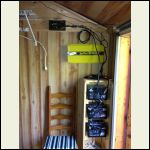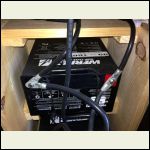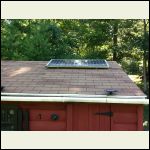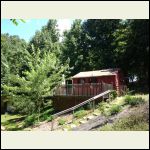|
| Author |
Message |
richmondgolf
Member
|
# Posted: 17 Jul 2013 08:18 - Edited by: richmondgolf
Reply
Hi all. New member here. About a year ago I purchased a cabin on 15 acres in southwest VA near the New River. Wonderful piece of land that has 2 small cabins and a shed. We are really enjoying our time up there. I wanted to get your take on the solar setup that was in place when we purchased the cabin. It seems to work fine - but wanted to see what other think since this was installed by the previous owner. I could not find any information on what the actual panel is. Also curious about what chances I have to expand as well as what benefit would there be to adding 2 more batteries to the series (i have two more cubbies for batteries if I wanted to use them).
Inverter: Go Electric Heavy Duty 1750w modified sine wave
Go Electric Regulator
3 - 12V 55AH deep cycle batteries in a series
Panel - unknown (any way to find out?)
My other question was the current set up for using the power is through a series of power strips plugged into the Inverter and then around the cabin (cabin is maybe 150 sqft). Does this diminish the power and performance? Is there a better method that is simple to install?
I love reading about what everyone is doing and trying to learn everything that I can.
*maybe an education lesson is needed, but I have a senseo coffee maker that says it is 1450 watts. I have a 1750 watt inverter, yet the coffee maker doesn't work. Am I missing something?
Inside set up
| 
Batteries
| 
Outside Solar Panel
| 
Main Cabin
|
|
|
Dillio187
Member
|
# Posted: 17 Jul 2013 09:28 - Edited by: Dillio187
Reply
judging from your pictures, your batteries are actually parallel wired, and in a manner that does not allow them to discharge evenly. They should be wired as shown in the lower left here for more even draw battery schematic
That being said, you usually don't want to add new batteries to old, it essentially pulls the new batteries down to the age of the old.
The panel looks like a decent sized panel, if you want to know what it is, you'll have to look under it, there will be a sticker on the back with it's specifications.
It looks to me from a glance that you are a little under-paneled for your battery bank, but without knowing the specs on the panel, or what charge controller it's hooked up to, I'm just guessing. (I can't tell what charge controller from the picture). You have a 165 ah, 12V bank which looks to be made of sealed type batteries. A charge rate around 15-18 amps would keep them happier.
The inverter is very large in comparison to the size of the battery bank. If you ran it anywhere near full load, it would flatten the battery bank in no time. If you aren't going to run large loads from it, I would recommend a smaller inverter which will draw less when not being used.
Great looking cabin!
|
|
CabinBuilder
Admin
|
# Posted: 17 Jul 2013 10:33 - Edited by: CabinBuilder
Reply
richmondgolf,
I think most batteries are designed to stand upright, yours appear to be on the side. You should check on your battery type if side position is acceptable.
|
|
groingo
Member
|
# Posted: 17 Jul 2013 11:22 - Edited by: groingo
Reply
First thing I see is the batteries are in your living space, personally I would enclose or isolate them and also vent to the outside for needed air circulation ie, fumes and heat from inverter etc.
I also see carry handles on the batteries that would indicate they should be in the upright position,now go buy a KillaWatt power meter to see how much power you really need by checking each appliance power consumption, all in all I like the place especially the half round siding!
|
|
Dillio187
Member
|
# Posted: 17 Jul 2013 12:20
Reply
they look like AGM/sealed type batteries to me. I don't see removable caps on them which would indicate so.
|
|
Steve961
Member
|
# Posted: 17 Jul 2013 15:36
Reply
Rich:
I strongly encourage you to find a different way to make coffee in the morning. Most every appliance with an electric heating element is a inefficient use of solar power. For example, your 165 AH battery bank can only provide about 1,350 watt hours of power. This assumes an inverter efficiency of 85% and a rather deep, but still safe, 80% discharge level. This would run your coffee maker for 55 minutes with nothing left afterwards. I don't know how long your coffee maker needs to run, but it seems like a rather inefficient way to make coffee - maybe a propane cooktop coffee maker would be better.
Another problem could be your inverter. While it says it's 1,750 watts, it's actually only rated for 1,500 continuously. It's also a modified, rather than a pure, sine wave unit which can cause problems with some electronics - not sure if your coffee maker has any electronics in it.
If you're dead set on making coffee with electricity, you'll probably need to upgrade you solar system with another panel, bigger/more batteries, and possibly a bigger/different inverter.
Steve
|
|
spencerin
Member
|
# Posted: 18 Jul 2013 02:01
Reply
richmondgolf
These are good replies because they are right on. I, myself, am kind of jealous you "inherited" what appears to be a working small solar system.
Based on the physical size of the panel, it appears to have a decent wattage (100W), but I disagree that you are "underpaneled" - it's probably just right. But, as stated, you'll have to look at the bottom of the panel for the specs, and same with the charge controller, and get specs for us amateurs to give you more info.
Coffee makers are notorious for drawing a lot of power for what they do. I don't know where Steve961 got his info, but Go Power!'s website shows the inverter is rated for 1,750W continuous, but only 2,150W surge, so I bet the surge of the coffee maker when you turn it on is exceeding the inverter's surge limit and that's why the maker won't turn on. I'd just go to Goodwill and buy a maker that draws +/- 900W and you might just be in bidness.
|
|
creeky
Member
|
# Posted: 18 Jul 2013 07:15
Reply
I'm going to go with ... use a propane stove for your coffee. you have a fairly small system, though a working one. talk about the basics. and it's probably not up to boiling water etc. but excellent for lights, a small tv ...
now that that's said. did you try plugging the coffee maker directly into the inverter? bypassing that cheapo power strip might help.
in my "studio" i ran armoured cable and surface mount boxes. Safer for sure. on the safety note, you might want to put a cover over the batteries. unless you don't have pets or kids or ...
and solar systems are like boats. you always want the next size up ...
nice looking spot.
|
|
|
Brknarow
Member
|
# Posted: 18 Jul 2013 08:28
Reply
I, personally, can't afford the 'grind it yourself' coffee beans and depend upon store bought for my fix and, from what I've read, percolators don't do well with the finely ground blends. I have found, but haven't purchased yet, a drip coffee maker that works by pouring hot water in an upper reservoir and drips into the lower. I do know they make 12v dc water heater kettles for RVs and truckers which should work fine on your system. The non-electric drip coffee maker I've found was at Lehman's so it's really too expensive, but here's the link if you're interested. https://www.lehmans.com/p-1735-non-electric-drip-coffee-maker.aspx
|
|
Steve961
Member
|
# Posted: 18 Jul 2013 11:34 - Edited by: Steve961
Reply
Quoting: spencerin I don't know where Steve961 got his info, but Go Power!'s website shows the inverter is rated for 1,750W continuous, but only 2,150W surge
The Go Power specification sheet below specifically states that the CONTINUOUS power rating for the 1750-HD is 1,500 watts.
Go Power GP-1750HD Specifications
|
|
CabinBuilder
Admin
|
# Posted: 18 Jul 2013 12:09 - Edited by: CabinBuilder
Reply
Quoting: Brknarow 12v dc water heater kettles for RVs and truckers
Interesting. Just looked them up - you can find ones that draw between 70 and 170 W @ 12V (6-15A). Not too bad. Assuming it boils 2 cups of water in 10 minutes, its only 1-2.5 Ah of battery drain.
The advantage of the solar solution is that, once you have an adequate system, it's free. Propane you have to buy, carry, refill.
|
|
Steve961
Member
|
# Posted: 18 Jul 2013 12:53
Reply
Coleman makes a drip coffee maker designed for cooktops.
|
|
Dillio187
Member
|
# Posted: 18 Jul 2013 16:42 - Edited by: Dillio187
Reply
Quoting: spencerin Based on the physical size of the panel, it appears to have a decent wattage (100W), but I disagree that you are "underpaneled" - it's probably just right. But, as stated, you'll have to look at the bottom of the panel for the specs, and same with the charge controller, and get specs for us amateurs to give you more info.
a 100W panel will have a charge rate in best of conditions around 6 amps. Into a 165ah bank that is a 3.6% rate of charge...that's awfully low and probably won't keep that bank very happy. If it's a 200W+ panel hooked into an MPPT charge controller, that would be much better.
|
|
richmondgolf
Member
|
# Posted: 18 Jul 2013 17:03 - Edited by: richmondgolf
Reply
Here is a picture of the charge controller.
Product Details:
URL (page 4)
|
|
Steve961
Member
|
# Posted: 18 Jul 2013 17:45 - Edited by: Steve961
Reply
With that charge controller, and your battery bank, you can easily ,and cost effectively, improve the performance of your system. Dillio is right in that you are underpaneled if you only have a 100 watt panel attached. Conventional wisdom is that you should have anywhere from 5-13% of the battery bank in panels. That would be 8-21 amps (i.e. ~135-352 watts) of panels. Your charge controller should easily be able to handle that.
I would recommend adding just one more 12 volt panel as two panels wired in parallel does not require any special fusing. Also try to buy as large of a panel as you can since the price per watt decreases dramatically as you go up in size.
|
|
spencerin
Member
|
# Posted: 19 Jul 2013 23:29
Reply
Yo, Steve-o! My bad. What I read showed 1,750W on their site, so they have a typo on their site.
richmondgolf, you are not underpaneled at 100W just because it is 100W. It all depends on the frequency and duration of use of your applicances. If you are using only a few small appliances occasionally during occasional visits, don't waste your money buying another +$200 panel and $100+ charge controller just because of some 5%-13% "rule of thumb". Your existing battery bank and charging rate will be fine. If your load on the bank is significantly greater, then, yes, you will have to consider upgrading.
I am a big proponent of cost-benefit analysis, which here begs the question "is the cost of buying a new panel and charge controller worth the marginal benefit when power usage is low?". And I like to debate sometimes. 
|
|
|

